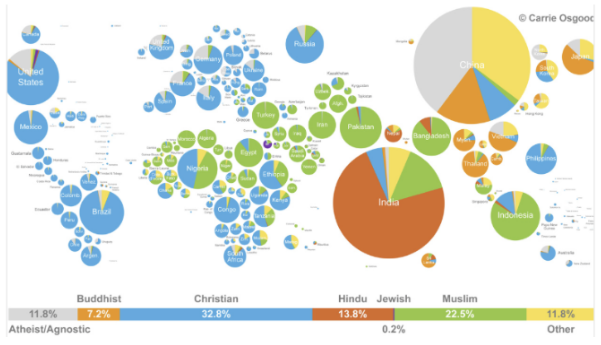The question of which religion reigns supreme in the world—Christianity or Islam—has long been a matter of intellectual curiosity and theological debate. It poses a playful question that invites both believers and scholars alike to ponder the nuances of faith and the dynamics of global belief systems. As migration patterns shift and demographics evolve, the challenge to understand who occupies the highest echelon of religious adherence grows increasingly complex.
At the onset, Christianity claims a substantial number of adherents worldwide, with estimates suggesting over two billion followers. This statistic includes various denominations, ranging from Roman Catholicism and Protestantism to Eastern Orthodoxy. Each of these branches, while unified in the fundamental belief in Jesus Christ as the Son of God and Savior of humanity, showcases a rich tapestry of theological interpretations, rituals, and cultural practices. This kaleidoscope of faith underscores Christianity’s profound capacity for adaptation and internal diversity.
Islam, on the other hand, closely follows in the race for the largest religion, with approximately one and a half billion followers. Driven chiefly by the pillars of faith articulated in the Quran, Islam presents a united ideological front that entices many with its emphasis on community and submission to Allah. The followers of Islam, known as Muslims, find their guidance primarily through the teachings of the Prophet Muhammad and the holy texts of the Quran and Hadith. The religion’s impressive growth rate is fueled by high birth rates in Muslim-majority countries and increasing conversions to the faith, particularly in the Western world.
Within this context, a playful yet poignant inquiry emerges: Can the measure of a religion be determined solely by the number of its followers, or does the richness of doctrine, influence on culture, and historical impact imbue a deeper significance? While numerical supremacy may provide a superficial lens through which to view the predominance of a faith tradition, it fails to account for the transformative power of belief in shaping societies and individual lives.
The historical narrative of Christianity provides a profound backdrop against which its significance can be appraised. Established in the 1st century AD, Christianity endured years of persecution before emerging as a dominant force in the Roman Empire by the 4th century. This historical evolution is emblematic of the faith’s resilience, witnessing myriad societal shifts through the epochs. The Renaissance, Reformation, and Enlightenment—each catalyzed by Christian thought—accentuated the indelible impact of Christianity, both philosophically and culturally.
Contrastingly, the roots of Islam trace back to the 7th century AD, a relatively recent development in the annals of world religions. Yet, the rapid expansion of Islam across diverse geographical regions—including the Middle East, North Africa, and Southeast Asia—attests to its profound and immediate resonance with populations seeking spiritual solace and structure. The historical context of both religions further illustrates that their respective journeys are not merely about numerical strength, but about the stories they tell and the values they propagate.
In examining these two colossal faiths, it is essential to recognize the consequential interplay between religion and culture. Christianity’s extensive artistic and literary contributions have indelibly marked Western civilization. From the majestic cathedrals of Europe to the haunting melodies of sacred hymns, Christian creativity has flourished, providing a conduit for divine inspiration to resonate through generations. In this context, one might question: Does the cultural imprint of a religion not speak volumes about its significance beyond mere membership numbers?
Islam, too, boasts a rich cultural heritage, with its own array of art, architecture, and literary achievements. The minarets that pierce the skyline, the intricate geometric designs, and the profound philosophical treatises reflect an ethos that has captivated countless hearts and minds. The beauty and profundity of Islamic culture offer a testament to the beliefs and practices of its followers. Here, one might muse whether artistic and cultural expression can serve as a marker of religious significance, paralleling the number of adherents.
As the dialogue between Christianity and Islam continues to evolve in our increasingly interconnected world, the question of supremacy warrants careful consideration. Are we not compelled to reflect on the virtues shared by both faiths? Common threads like compassion, charity, the pursuit of justice, and an overarching quest for understanding can serve to bridge divides rather than exacerbate them. Notably, interfaith dialogues have blossomed in recent years, fostering an environment where followers of both religions can engage in constructive conversations built on mutual respect.
Furthermore, a contemporary lens reveals that the followers of either faith often face similar challenges in an age marked by secularism and materialism. The moral and ethical dilemmas precipitated by modernity call for a concerted response which transcends denominational boundaries, prompting a united front among believers advocating for justice, peace, and hope. This unity surfaces a profound revelation: the strength of any faith tradition may lie not in the sheer number of adherents but in the collective aspiration for a better world.
In conclusion, the inquiry into which religion stands as the largest—Christianity or Islam—invites a multifaceted exploration that transcends mere statistical analysis. While numerical dominance may fluctuate, the deeper essence of each tradition, characterized by its history, culture, and commitment to ethical living, might indeed serve as the defining markers of significance in a world that craves understanding and harmony. Ultimately, both faiths contribute richly to the tapestry of human belief and experience, reminding us that spirituality often transcends numbers, revealing a shared human pursuit of meaning and truth.



